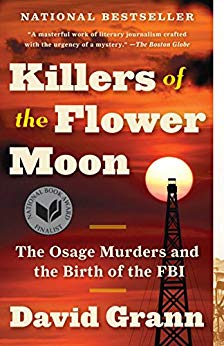

This article is an excerpt from the Shortform summary of "Killers of the Flower Moon" by David Grann. Shortform has the world's best summaries of books you should be reading.
Like this article? Sign up for a free trial here .
Who was Dick Gregg? How did this outlaw contribute to solving the Osage murders investigation?
Dick Gregg was a member of the Al Spencer gang. While he was in prison, he offered information to investigator Tom White that later lead to a huge break in the Osage murders investigation in 1920s Oklahoma.
Keep reading to learn about Dick Gregg and his role in this landmark case.
Who Was Dick Gregg?
Dick Gregg was a member of the fearsome Al Spencer gang in the 1920s. Dick Gregg was a known criminal and stickup man who offered assistance to Tom White as he investigated the Osage murders in exchange for a reduced sentence on his jail time.
The Conspiracy Unravels
Before we explore Dick Gregg’s involvement in the case, we need to know what the charges were.
The Osage Tribal Council had decreed that each member of the tribe was to receive an equal share of the royalties from the oil money, known as headrights. Individuals were not permitted to buy or sell headrights—this was done in an attempt to keep the oil money in Osage hands. But they could be inherited. An Osage who suffered many deaths in their family could find himself or herself the owner of multiple headrights.
As he studied the probate records, Tom discovered that many headrights had come into the possession of Mollie Burkhart, married to Ernest Burkhart, nephew of William Hale. Ernest was known to be highly influenced by his domineering uncle. When all of this money came to Mollie, it would be easy for Hale to exercise control of it through his nephew—though it would be even easier if Mollie were to be killed, too.
This explained the precise pattern and order of deaths in Mollie’s family. The divorced and childless Anna had been the first to be eliminated, with her headright going to her mother Lizzie. Killing Anna first ensured that her assets would not be divided up between multiple heirs. Lizzie herself was the next target, having willed her headrights to Mollie and Rita, her surviving daughters.
This also explained why the next victims, Bill and Rita Smith, had died in a bombing attack, which was an unusual method of killing. In fact, the Smith murders were done this way because it was critical that the two died at the same time. If only Rita had died, her headrights would have gone to her husband Bill Smith. But because the couple died mere days apart, Rita’s headright reverted to her only surviving heir—Mollie. It all began to make sense as the outlines of the murderous plot became clear to Tom White. By conspiring to have all the members of Mollie’s family killed, Hale was maneuvering to have all their headrights bequeathed to her. Once Mollie herself was murdered, the oil wealth would be his to exploit.
But who was responsible for following through on the murders? Would Hale have hired someone? Tom White leveraged his resources and turned to Dick Gregg.
Stickup Man Dick Gregg Offers a Break in the Case
Despite the progress that Tom White had made in Osage County (which he had dutifully reported to the Bureau), J. Edgar Hoover was growing impatient with the state of the case by the fall of 1925. He wanted convictions and the glowing headlines they would bring. By this time, a full-fledged diaspora was taking place within the Osage community. Families fled the county and state in terror. Some even fled the United States altogether, choosing to settle in Canada or Mexico.
Through a local attorney, Tom arranged a meeting with the stickup man Dick Gregg, known as a member of the fearsome Al Spencer gang. At that time, Dick Gregg was serving a sentence in a Kansas penitentiary for armed robbery. Dick Gregg agreed to meet with Tom White and share what he knew, in exchange for a possible sentence reduction.
Witnesses Disappear
At his meeting with Tom White, Dick Gregg revealed that Hale had paid the Spencer gang $2,000 to murder Bill and Rita Smith. Dick Gregg claimed that he had refused this assignment, deeming the contract killing of a woman to be dishonorable, even by outlaw standards. He also mentioned the name of another associate, Curley Johnson, who had knowledge of the Smith slayings. But Johnson, Tom learned, had died—apparently of alcohol poisoning, though it was quite possible he had been another victim of the Reign of Terror. Another potential witness, the bootlegger Henry Grammer, with whom Hale had been overheard talking about the conspiracy, had died in a car accident in June 1923.
Through another informant, Tom discovered that an outlaw named Asa Kirby had been responsible for rigging the charges that killed Bill and Rita. But Kirby was also unable to testify. Two weeks after Grammer’s death, he had been killed by a store owner during an attempted burglary. It came as no surprise to Tom to learn who had tipped off the store owner about the break-in—William Hale.
The conspiracy was eating its own. It was clear that Hale was systematically killing anyone who had been involved in the Osage murders and might be able to implicate him.
In October 1925, White received a new tip, this time from a prisoner in the Oklahoma state penitentiary named Burt Lawson. Lawson claimed that his wife had carried on an affair with Bill Smith, while he had been working as Smith’s ranch hand. His jealousy and bitterness toward Bill Smith had made him an easy target when the Hale conspiracy came to recruit him. Lawson claimed that, in early 1921, Ernest Burkhart and William Hale had offered him $5,000 to place the fuse under the Smith house that set off the explosion. Hale had even provided him with the tools for making the bomb, including the nitroglycerin and the coiled fuse. Lawson, after some pressure from Hale, agreed to set up the explosive device and detonate it. He had waited until he was sure Bill and Rita were asleep and then lit the fuse, watching the house blow up.
Though Dick Gregg did not participate in the Osage murders (at least not officially) he offered a huge break in the case for investigator Tom White, who was able to slowly piece together the conspiracy and connect it to William Hale.

———End of Preview———
Like what you just read? Read the rest of the world's best summary of David Grann's "Killers of the Flower Moon" at Shortform .
Here's what you'll find in our full Killers of the Flower Moon summary :
- How the Osage tribe had vast oil wealth, but had it seized by their murderous neighbors
- The brutal and unresolved murders of Osage Native Americans
- The complicated history of the FBI in profiting from the Osage murders






